| Columns Retired Columns & Blogs |
I am perplex at the fairly wide and deep suck-up between 1000hz and 1800Hz?
That can’t be good. What would cause that?
For logistical reasons, the sample of the Wilson Yvette I measured—serial no. 166, kindly loaned by Manhattan retailer Innovative Audio—was not one of the pair auditioned by Brian Damkroger. I used DRA Labs' MLSSA system and a calibrated DPA 4006 microphone to measure the Yvette's frequency response in the farfield, and an Earthworks QTC-40 mike for the nearfield and in-room responses.
The Wilson's specified sensitivity is 86dB/2.83V/m; my estimate was a little higher, at 87.6dB(B)/2.83V/m. Wilson specifies the Yvette's nominal impedance as 4 ohms, with a minimum value of 2.94 ohms at 90Hz, which my measurement of the speaker's impedance magnitude confirmed (fig.1, solid trace). The electrical phase angle (dotted trace) is generally low, though a combination of 5 ohms and –47° phase angle at 57Hz suggests that the Yvette will sound best with amplifiers that are comfortable driving 4 ohm loads.
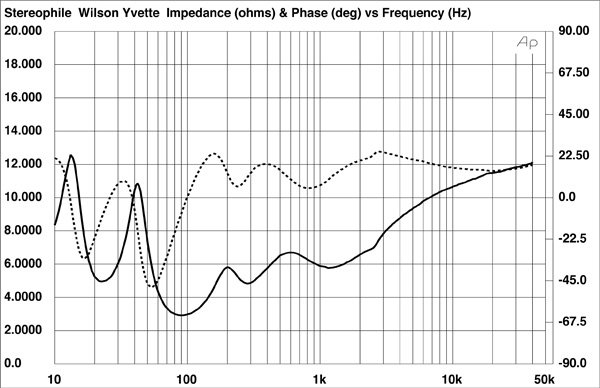
The impedance traces are free from the small discontinuities that would imply the presence of resonances of various kinds. When I investigated the enclosure's vibrational behavior with a plastic-tape accelerometer, I found a resonant mode at 508Hz on the side panels level with the midrange drive-unit, and on the rear panel next to the port that loads the woofer. This was relatively low in level, however; coupled with its high frequency, this means that it will probably not result in audible midrange congestion.
The Yvette's impedance-magnitude plot has a saddle in the bass centered on 23Hz, indicating that this is the tuning frequency of the port. The blue trace in fig.2 reveals that the output of the woofer, measured in the nearfield, has the expected minimum-motion notch at 23Hz, and that the port's nearfield response (red) broadly peaks between 15 and 60Hz. The levels of the woofer and port responses are plotted in the ratios of the square roots of their radiating areas; it looks as if the port doesn't quite extend the output of the Yvette's woofer to its tuning frequency.
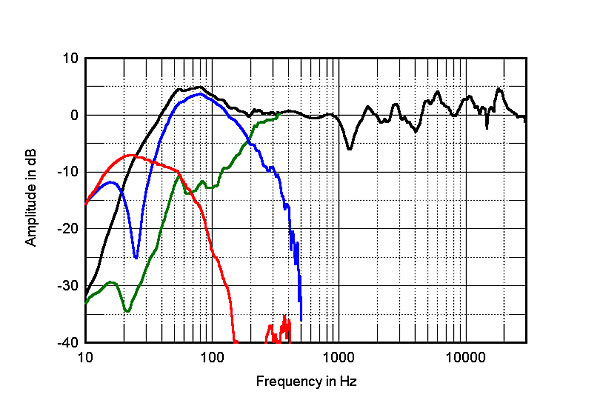
The green trace in fig.2 shows the nearfield response of the midrange drive-unit. It rolls off below 200Hz, though with a plateau in its low-frequency output between 50 and 100Hz. The black trace below 300Hz in fig.2 shows the complex sum of the nearfield midrange, woofer, and port responses, taking into account acoustic phase and the different distances of each radiator from a nominal farfield microphone position. The rise in the midbass is due to the nearfield measurement technique, which assumes that the drive-units are mounted in a true infinite baffle; ie, one that extends to infinity in both the horizontal and vertical planes.
Higher in frequency in fig.2, the black trace shows the Wilson's farfield response, averaged across a 30° horizontal window centered on the tweeter axis. Although the overall balance is even, with a slight rising trend in the treble, several small suckouts and peaks are evident between 1 and 20kHz. This kind of response looks worse than it sounds, as to some extent the peaks will be balanced by the dips, reducing any tendency to coloration. This graph was taken without the grilles. Those slightly changed the pattern of peaks and dips, but didn't smooth out the response.
The plot of the Yvette's horizontal dispersion (fig.3) indicates that the on-axis dips do fill in somewhat to the speaker's sides. This graph also shows that, with the fairly wide baffle in which it's mounted, the tweeter becomes very directional above 15kHz, which might correlate with BD occasionally thinking the speakers rolled off the highs a little when he moved his head. In the vertical plane (fig.4), a sharply defined suckout at 1300Hz develops more than 5° above the tweeter axis. This suggests that this is the upper crossover frequency, which is lower than usual for a 1" tweeter.
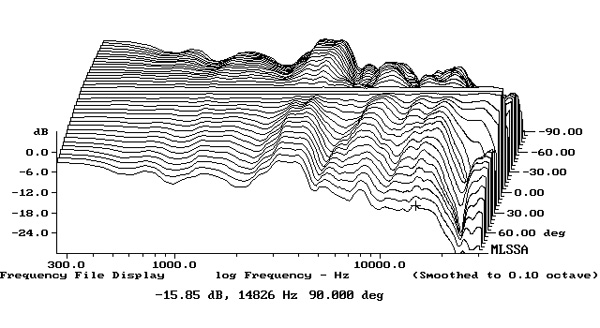
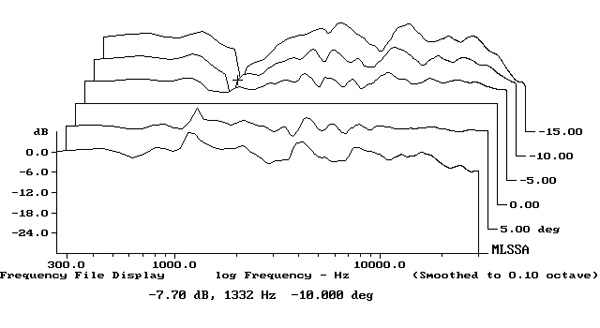
I examined the Yvette's spatially averaged response in my listening room. (For this I average 20 1/6-octave–smoothed spectra, taken for the speaker placed first in the left then in the right positions using a 96kHz sample rate, in a vertical rectangular grid 36" wide by 18" high and centered on the positions of my ears.) The result, with the speakers driven by an Ayre Acoustics EX-8 integrated amplifier, is shown in fig.5 (red trace). For reference, this graph also shows the spatially averaged response of the Wilson Alexia 2 (blue trace), which I reviewed in July 2018. Though the Yvette has a little more energy in the mid- and high treble than the Alexia 2, the two speakers produce remarkably similar in-room responses, particularly in the bass, where the effects of the room's acoustic modes dominate a speaker's intrinsic behavior.
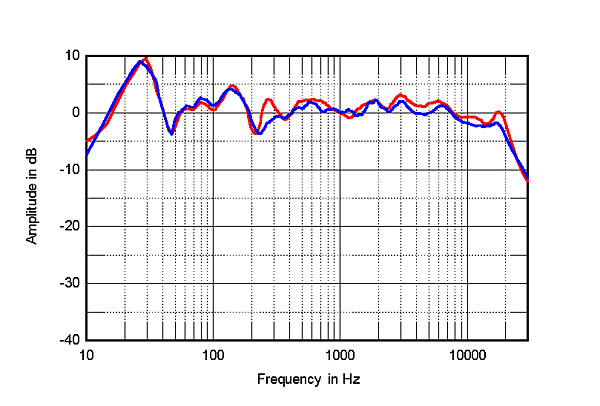
In the time domain, the Yvette's step response (fig.6) is very similar to that of every Wilson speaker I've measured in the past few years. The tweeter and woofer are connected in positive acoustic polarity, the midrange unit in negative polarity, and the decay of each unit's step smoothly blends with that of the next lower in frequency, suggesting optimal crossover design in conjunction with the slight slope-back of the upper baffle. The slight discontinuity just before 4ms suggests that the best integration of the outputs of the tweeter and midrange unit actually occurs just below the tweeter axis, which is around 40" above the floor with the speakers on spikes. Other than some low-level ridges of delayed energy in the treble, the Wilson's cumulative spectral-decay plot (fig.7) is fairly clean.
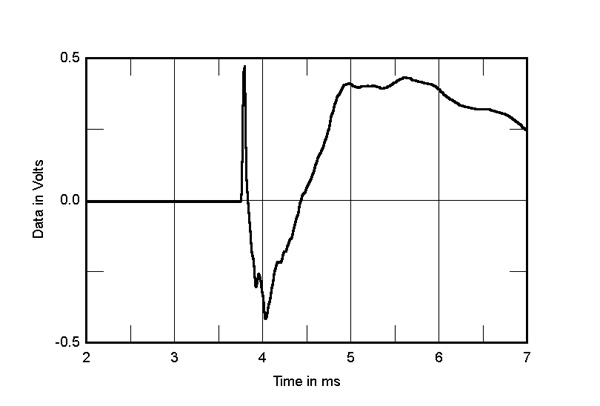
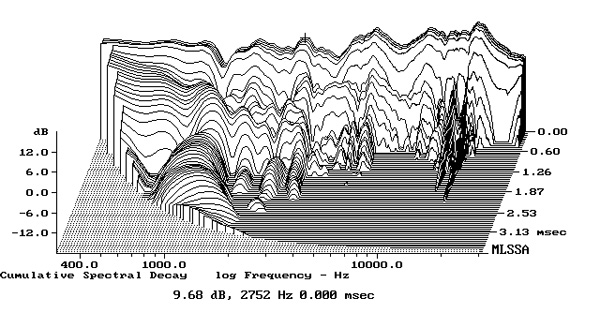
Overall, the Yvette offers good measured performance. I'm still astonished by how close its in-room response is to that of the Alexia 2—which costs more than twice as much.—John Atkinson

I am perplex at the fairly wide and deep suck-up between 1000hz and 1800Hz?
That can’t be good. What would cause that?

The dip appears to fill in below the tweeter axis which seems to be the preferred listening axis based on time response. As a result the dip doesn't really show up in the room response.

one thing is to read about this things , another is to actually sitting down and listening to a loudspeaker , i did that at a dealer using a Devialet and NordOst cabeling and can only say these speakers are to my ears amazing.
Have listened to Magico speakers several times , and they are not bad but somehow they just dont do it for me....i feel like the sound is inside and never really released.

Better value for the money than Alexia2? :-) ..........

Value for Money is not a descriptive applicable to any Wilson Product and never has been. I sold Wilson in 1980s
Wilson aspires to be an exclusive Luxury Product for Deep Pocket Social Elites. It's a Velvet Rope Company that coddles it's owners like the Chicago Rolls Royce Dealer took care of it's small fleet of exclusive ownership.
Wilson products will always place as Class A Recommended.
I kinda liked Wilsons but not for price/performance reasons.
They play well, or at least as well as the electronics in Front of them..
Wilson would demo them using Tape and the nicest electronics, they always sound "Good". I still preferred Magnepan instead ( as do most Audiophiles )
Got mucho dinero and wanna show it, buy Wilsons.
Tony in Michigan
ps. my 22 yr old Sennheiser HD 580s have nicer transducers and sound better !
ps. Infinity IRS has always crushed Wilson's performance. New PS AN loudspeakers are assuring even higher performance realizations.

Got to listen to this speaker last month. It is bright and boomy and that's before I saw the measurements.
Glad I was reviewing an amp that had tone controls because I absolutely needed them. So far from neutral or well balanced.

Did you like their sound? ........ What were the associated equipment used, such as the amplifier(s) etc? :-) .......

No. I was really happy to get the amp home and plug it into my speakers and hear everything get fixed.
It was so bright and bassy I thought there was a crossover configuration issue. Is this one with adjustable levels? If so you'll have to be careful.
Associated equipment at the store was a Marantz SACD/DAC and Luxman 509ux playing Tidal. Had to turn bass and treble to around 10 o'clock to get it listenable.
If you like the B&W / Golden Ear / Focal top ends you may like this speaker though. It has that same treble "color" or lack of smoothness. If you prefer glass smooth treble like Magico / YG / Sonus Faber this is NOT for you at all. This is in addition to the level / brightness. The ragedness of the tweeter was made far worse by the uptilt. You are free to disagree with me, you'll know if I'm right or not in moments.
The published FR may very well be why I felt the Marantz had such a case of digititis. I really have not heard a DAC sound this badly in a very long time, but the Yvette made it screech.
FYI, my home system is a Mytek Brooklyn, Luxman 507ux and custom speakers here:
https://speakermakersjourney.blogspot.com/2017/12/snr-1-two-way-high-end-diy-monitor.html
The dealer had a larger Wilson at 90 degrees in the same room driven by D'Agostino gear and Aurrender. My gods it was 20x a better system. The treble issues were gone, and the balance was spot on as is.
P.S. In case you are wondering why I bought the amp when the system sounded like hell, it was a super great discount and not available for home audition, because there were 3 people who would buy it already. It was the very last 507ux in the US. I took a chance, thinking I knew what I was hearing.

The Stereophile reviewer used tube amp mono-blocks, for the review ........ That might have helped the sound quality, especially in the treble region, my guessing :-) ........

I remembering auditioning the little Wilson WATTS twice, once at Skywalker Studios, with a Redbook standard DAT as a source [horrible, horrible, horrible] and once in John Curl's living room with a Linn LP12 into a CTC Blowtorch [amazing]. I suspect that the Wilson Audio design philosophy results in gear that is unusually revealing of upper-frequency garbage from source components. Which makes sense as those WATTS were intended for monitoring recordings.

They aren't "revealing" so much as ragged.

–very promising sounded also to me their Sasha DAW alleged culmination. I have never heard Yvette or Alexia 2 (the original was surprisingly boring though) both reviewed at Stereophile, so I can’t subjectively comment on their performance. I was most eager anyway to meet in person with universally glorified Sabrina Wilson model ;-} which finally proved to be one of the worst-sounding loudspeakers regardless of price and one of the main reasons I have stopped paying attention to all unanimously exalted audio reviews.

To me it has always been a puzzle how Wilson ever became "High End".
Look at the impedance, not even the best amp of the world will perform better at these low impedances most often lowest in the area, where music contains most energy.
And then the time domain measurements. Midrange Driver units working in negative phase, lots of delayed energy.
It seems like Wilson only puts their attention to things that are visible from the outside. Heavy cabinets, expensive terminals and a lot of details with minor influence of performance.
A state of the art speaker should have a mostly even and not to low impedance, allowing the amp to perform at its best. And of course all drivers should be connected in phase, and should have a waterfall plot with absolutely no signs of resonance and as little delayed energy as possible. In most cases the dispersion pattern should be optimized off-axis, as the off-axis energy is dominant in the listening room. If so, most energy released will have the same frequency response.
Some of this should be logical stuff. But to me the measurements look pretty terrible, and I don´t really understand that Stereophile are not calling them by their name "Idiosyncratic"

One example of such an almost ideal loudspeaker you describe is Revel Ultima Salon2 ........ reviewed in Stereophile ........... $22,000/pair :-) ..........

In terms of the impulse response, I disagree that all drivers need to be coincident. There are a handful of makers who do this, Thiel, Vandersteen amont the most notable, but they are by no means the only makers of amazing sounding speakers, and a lot of us simply aren't moved as much by this as some consumers are.
Lots of speakers which are wired similarly sound better than the Yvette.

True ,,,,, A lot of British loudspeakers are designed and engineered this way ....... ie. the woofers and the tweeters are connected in the opposite polarity :-) ..........

It's American too. It's just the nature of multi-pole box speaker design. 95% of 2-way speakers invert the two drivers relative to each other. I designed a 2-way that did not and it was really pure luck.

As answer to you and also the others responding to my writing, I must say, that what the British do, is not necessarily right.
A lot of Britsh made speakers are absolutely idiosyncratic, amongst them Harbeth.
Also B&W have a very precise idea about how their speakers should sound. And they always do. Like it or not, but you can always count on the B&W sound. I do respect that, but I do not consider design like that as "High Fidelity".
It sells, B&W is to day the largest maker of high end passive speakers in the world.
Anyways none of the speakers mentioned by me produces impressive time domain measurements, They are heavily infected with delayed energy.
Any electric circuit behaving just slightly like shown, would be blamed for poor resolution and resonance, just as this should be too.

Active loudspeakers with built-in DSP, like the recently reviewed KEF LSX can correct for the time domain response and make them time-coincident ie. all frequencies arrive at the same time at the listener .......... Look at the measurements of KEF LSX ......... JA1 describes that phenomenon ....... Some of the favorably reviewed speakers like the passive KEF LS-50 and Spendor A7, do have the woofers and tweeters connected in the opposite polarity :-) ........

A correction: DC driver polarity - the red and black tabs connecting drivers to crossover - does not determine acoustical phase, meaning that it cannot alone contribute either an in-phase or an out-of-phase acoustical condition. Transfer functions between drivers convolve phase - influenced by acoustical center offsets, or "time" - and as the measured results here show, crossover filters designed for specific transfer functions do an excellent job of it.
DC driver polarity is not acoustical phase. Inverted connections are perfectly fine and, as with non-inverted polarity, may just as easily provide a usable, even superb final response.

... Wilson's Daryl Wilson and Harbeth's Alan Shaw?
Mr. Shaw asserts that his bespoke plastic formulation (aka Radial) is the ideal bass/midrange cone material, while Wilson continues to use some variation of paper.
Likewise, Harbeth keeps using decades-old BBC-derived thin-wall, lossy-jointed style wood cabinets, while Wilson has developed their proprietary X-material and S-material composite materials.
In addition, include a direct comparison between comparably priced speakers from each company - for example the Harbeth Monitor 40.2 versus the Wilson Sabrina.

Two other examples in the Sabrina price range are Revel Ultima Studio2 (reviewed in Stereophile) and Yamaha NS-5000 ....... NS-5000 was reviewed by many other audio journals very favorably :-) ........

I have a friend who has a pair of one of the Wilson speakers that starts with an “A.” Alex? Alexia? Alec? Alicia? Anatoli? Anthony? Aoxomoxoa? Anyway, those babies do everything right.
The dynamic range they have feels unlimited. Best I’ve encountered.
That would be a great shoot out to have with the Revels!
I have listened to those Yamahas, almost as good as the NS 1000 speakers!

Do you remember what are the associated components your friend was using with the Wilson speakers, such as the amp, pre-amp, digital or analog etc.? :-) ..........
Also, how did the Yamaha NS-5000 sound? ..... good or not so good? ........ also, do you remember what are associated components used with the Yamaha speakers? :-) .........

For the Yamahas, it was with the new Yamaha electronics.
I have some vintage (crossover components refreshed) NS 1000M speakers I use with a Yamaha C4 and M4 preamp and amp and an Oppo 205.
The old and new speakers are similar in size/shape/driver positions, so that alone may account for a lot of sonic overlap! Those old beryllium drivers are nice.
Both old and new have surprisingly good bass extension and detail with solid dynamics!
The Wilsons were listened to via...hmm...I am lapsing! Affordable solid state gear via a hard drive. I will owe you that info!

Thanks Anton, for the info ........ Don't you think Stereophile should consider reviewing the new Yamaha NS-5000, after reading your positive comments? :-) ..........

If I were in the industry, I would love to review mods, vintage, and current gear vs it’s ancestors.
Oh, wait...my fantasy is to be Art Dudley!?!
Well, that’s fine, he rocks it.
I agree that a now vs. then Yamaha comparo would be cool.

You have to grow a beard, if you already don't have one ........ that is a job requirement :-) ........

Wilson VS Harbeth. Unfortunately, it probably will never happen.

at the Cash Register.
Wilson has been winning it, continues to win it with Audio Magazines & Audio Shows Proclaiming Wilson the Winner.
Anyone hoping for a Serious Loudspeaker Debate need only observe the Andrew Jones vs. Steve G. 2019 AXPONA Seminar in 3 Parts, it's brilliant.
Wilsons are sort of like a fully loaded Chevy Suburban or Cadillac Escalade
Harbeths are sort of like the Mini-Cooper S
I'm a ProAc Tablette lover ( for what it's worth )
Tony in Michigan

... price-wise the Harbeth product line-up tops out where the Wilson product line-up is just getting started. Maybe the sales success of the 40th Anniversary limited edition models will make Alan Shaw sufficiently cynical to create his own $750K magnum opus speaker before he decides to retire.
Regarding Steve Guttenberg playing the straight man to Andrew
Jones at AXPONA, although he discussed tweeter materials, unfortunately AJ didn't get to talk about materials for bass/midrange drivers. The product literature for the ELAC Debut series states that the aramid fiber used is superior to paper or polypropylene. More expensive AJ-designed models use aluminum. I'd liked to have heard him expound on that topic.

Wilson speakers, in general, seem to work well with D'Agostino amps and pre-amps :-) .........

Hi, is there any reason in particular the polar measurements shown in Figures 3 and 4 are always normalised to the on-axis measurement in your reviews? I always find it a bit difficult to read the polar measurements in relation to the on-axis this way, especially if the on-axis originally had a big peak or dip that smooths out in the polar ones but due to normalisation shows instead as an opposite dip or peak respectively. I think it is counterintuitive and can be misleading if you fail to notice the normalisation. You could just show the actual polar measurements and that would require no interpretation.

is there any reason in particular the polar measurements shown in Figures 3 and 4 are always normalised to the on-axis measurement in your reviews?
I have occasionally showed the un-normalized plots, but decided that for consistency's sake over the 30 years I have been publishing dispersion plots to stick with the normalized versions.
John Atkinson
Technical Editor, Stereophile

Could you show both? That would be the best of all worlds for us readers who focus on speaker measurements.

Per the Wilson Yvette manual, the midrange and tweeter levels are adjustable. Please keep this in mind when reading my previous comments, it is VERY likely the dealer had the midrange deliberately suppressed, as they were also playing out of phase when I first heard them.
https://wilsonaudio.com/products/yvette

The reviewer, who has heard many speakers, claims he'd never found one in which he felt so naturally inside the recording space... At 86 dB/w/m sensitivity this seems quite an unlikely claim... Only gazillions VTL watts could make these $25,000 things move, but for how long? As for the lengthy "animal" box description and the foul language, and yet packing the "animal" back to its distributor, this review is quite unconvincing.

I switched to the Sabrinas (from Focal) a couple of years ago. I mainly did this to simplify and move away from separates. I am driving them with a Pass INT60. The Focals were hard to drive too, but mainly in one region due, if I remember correctly, to their 4th order xovers. They were faster, a bit more analytical, and could be sibilant at times. I find the Pass drives the Sabrinas easily and the sound is a bit more relaxed. They definitely don’t have the definition of the Be tweeters in the upper registers. I am not sold about the way they look - one guest thought they looked like baby coffins. In all, this being a game of compromises, I am very happy with my switch to Wilson.
I do think there is much to legitimately criticize with Wilsons, and I rarely see reviews that are very critical. On the plus side, their cabinet construction is second to none. There are a ton of “high end” speakers that continue to use MDF and wood glue. Wilsons are rock solid and dead.

... 508Hz, but the customary cumulative spectral decay plot derived from the accelerometer output is missing from this review, so we can't readily compare it to those for other speakers.

I do not own Wilson speakers. I auditioned a few mostly driven by high-end tubes in well-controlled rooms. It was apparent to me they are very hard to optimize. I came to a quick conclusion that it would take electronics and cables 3-10x cost of Wilson speakers in order to sound truly great. My uneducated guess is - their tweeter just sucks!! Don't get me wrong. I am not saying they sound bad. Peakier treble than some, slower than some, hard to position than some, but Wilsons certainly do not sound 'bad' by any mean.
I find Brian's system was already optimized for Wilson. He simply swapped Sophia 2 to Yvette in a system which was built for Wilson. His amp, VTL, is known for a good pairing with Wilson. His old VTL Ichiban's are warmer sounding than the current generation, which must have helped with Yvette. In my humble opinion, for most people who drop Yvette in their current system should never expect such a praiseworthy sound. As an objective reviewer, I wish Brian had included other amps in his audition. As an objective magazine, I wish Stereophile did not assign a Wilson loving person to review another Wilson.
Anyway, Wilson looks gorgeous to my eyes. To me, they are a drool-worthy eye candy, which sounds 'good' out of the box - but is capable of sounding 'great' with careful pairings and a lot, A LOT, of efforts. However, doesn't that sum up the most high-end speakers? For the look alone I'd love to own a pair at one point.

I have owned the Harbeth Super HL5 Plus speakers for two months. I spent two hours today auditioning the Sabrina's and the Yvette's.
Cutting right to the chase, my Harbeths I hear, the Yvettes I hear and feel. What do I mean? To start with, the Yvette's are every bit as good in the treble and midrange as the Harbeths (I think the Yvettes reveal slightly better micro details). However, the Yvettes not only reveal a lot more detail in the mid-bass region, it actually creates something akin to a "compression wave" in the room. This is not to be confused with the bass is "boomier" or "thumpier", it is much much more than that.
With the Harbeths playing loudly in my family room I can hear the music clearly, but I'm missing the room actually reacting to the music. If you listen to live music in a small room you will know what I mean by this.
For example, if I strike a C1 note on my grand piano a listener can hear the note play, the Bass Effect, reverb and decay, and also the room reaction to the playing of that note. The Yvette's are the closest thing I've heard that replicates the third effect most closely with the real thing.
So.... As far as music accuracy is concerned across all frequency ranges, my Harbeth scores an 8/10, the Yvette's score a 9/10. But as far as "you are actually at the music venue" is concerned, the Harbeth's score a 7/10, the Yvette's a 10/10.
This rather obscure observation may not matter to most folks, which is perfectly OK. I've been listening to speakers in the $10-$25 range for 40 years, and only today did I hear this effect. Whether or not this justifies the large price for these speakers is not for me to say.

Good comment Brian!
I get what you are describing.
A lot of audiophile speakers create a sonic holography happening somewhere between and behind the speakers. But some speakers are better at recreating a sense of palpability - of the performers actually solidly there, moving the air in your room, directly connecting you to the sound of the music.

Thanks for your comments RH!
There was one other thing I noticed today during the speaker auditions that I can't quite explain.
To start with, when I auditioned my Harbeth's last night preparing for today's activities, I made sure that for the half-dozen tracks I selected for today, I used my Radio Shack Sound Pressure Meter to make sure I was peaking just below 90 db. At that level the speakers were LOUD but not unbearable in my room.
Today as I listened to the first track I adjusted the volume up to what I perceived to be the same loudness. However, when I checked the meter the Yvette's were peaking at 95 db. When I adjusted the volume down to a 90 db peak, the Yvette's were comfortably loud but not fatiguing or "close to the edge". In other words, the Yvette's could play louder with less fatigue or abrasiveness.
Not really sure why this would be. Just another observation....

That is a very good point ....... That means that the speaker can play loud without compression during dynamic peaks ...... That means that there is good speaker engineering and good quality drivers (transducers) :-) .........

... without incurring a financial penalty, you may want to try them with a REL subwoofer - or two - to see if that provides the sense of "room reaction" you're seeking.
https://rel.net/product-category/powered-subwoofers/
OTOH, if your budget extends to the price of the Wilson Yvette, then you ought to audition the Harbeth Monitor 40.2, which has a larger woofer (and cabinet) than the Super HL5 Plus.
https://www.harbeth.co.uk/hifi-speaker/20/Harbeth-Monitor-40.2-loudspeaker
Other speakers you may want to audition are the KEF Reference 5, the Spendor classic 200 (and/or 100), and the PMC Fact 12.
https://www.stereophile.com/content/kef-reference-5-loudspeaker
https://www.spendoraudio.com/wp-content/uploads/Spendor-Classic-Data-Sheet_website_version.pdf
https://pmc-speakers.com/products/fact/fact/fact12
Incidentally, what amplifier are you presently using with the Super HL5 Plus?

KEF Blade Two, B&W 802 D3 and Revel Ultima Salon2 are also in the Wilson Yvette price range :-) ........

Thanks for your comments.
I had the fortunate experience to audition the Harbeth Monitor 40.2 this past December for a few hours. They were fantastic as I expected, with more lower-end extension than the Super HL5 Plus. Based on what I heard yesterday however, the 40.2's did not have quite that "OMG" factor that the Yvette's revealed. In all honesty, had I started from scratch as far as upgrading my then under $2K Paradigms I might select the Harbeth Monitor 30.2's (Stereophile Class A under $7K) with a decent pair of stands. I would then have to find a sub that could deliver that "sonic wave" low end. With a budget of $2K for a sub woofer I'm sure that could be done.
Having said that, after thinking about this for 24 hours I'm very comfortable with my decision to purchase the Yvette's.
I have learned however in the past four months that my return to quality two channel analog stereo requires a significant investment in the proper speaker setup. In my 40 years in A/V I had never owned speakers over $2K a pair until this year.
My amplification is Rogue Audio's Pharaoh integrated amp. So far I am thrilled beyond words, and to buy from a local Pennsylvania company that makes such quality products at fair prices makes it even sweeter.

... you might want to inquire from where the vacuum tubes and power amplifier modules (among other parts) are sourced.

On Monday I re-listened to several tracks that I had auditioned on the Sasha's and Yvette's last Saturday.
My initial impressions were confirmed, as the Wilson speakers had every bit of the treble and mid-range clarity and presence that my Harbeth's are famous for. The difference that makes the Wilson speakers more realistic ("the you are there experience") is everything else below the mid-range.
Re-playing Donald Fagan's I.G.Y. from "The Nightfly" showed me how much better the Yvette's convey that sense of realism. The difference between my Harbeth's and the Yvette's is astounding in that regard. I don't want to parrot what the reviewer said above, but now that I've heard the Yvette's there is no going back.
Side Note 1: While my speaker buying decision process was going on, the head installer from Wilson Audio called me and spent an hour walking me through the ultimate setup of the Yvette's in my room (I sent detailed pictures) and how (or if) a sub might be needed. If that's not a great example of customer service I don't know what is.
Side Note 2: Not that it makes any difference or is anybody's business, the speakers I just purchased are trade-ins the dealer received a few months ago. Wilson speakers are extremely expensive, but looking around there are good deals to be had on either show-demos, trade-ins, or discontinued speakers. In my case, the warranty is three years and as far as I can tell these speakers are cosmetically excellent and sonically perfect.

They were setup by the folks at JS Audio in Bethesda. I participated in the WASP process; it was amazing to hear how moving the speakers one inch backward or forward made an audible difference.
Eventually the speakers were setup about 34 inches from the back wall, toed-in about 20 degrees. Listening distance was about 11 feet, which is 1.5 times the distance between the tweeters.
It was very impressive to see this process in action. In all my salesman and his installer were at our house for almost three hours.
I'll save my initial impressions for another day. Needless to say the sound was spectacular; I'm completely satisfied.

My admiration for these speakers has actually grown from my initial impressions. I have probably listened to about 50 recordings (FLAC, CD, LP) so far and in each case I hear micro-details that I have not heard before now. Most of these recordings I have had around for 30+ years so I know exactly what they sound like in my home.
There is one point, however that I need to make. No speaker is perfect and the Yvette's have one minor issue that I am grappling with. I know exactly what the reviewer was hearing with his "holy shit" comment. At a certain listening level (above 90 db peak) these speakers take you to the performance; you actually feel the "sonic wave" so to speak. However, in my listening room 90 db is too loud (for me, my wife and my cats). About 85 db is my limit. So, I am experimenting with adding a sub to see if I can get a bit more low end at a lower listening volume. Wilson tries to dissuade owners from doing this (probably rightly so), but it's my house.
One other slightly negative thing I can say; I now think my amplification is not quite up to the task of properly driving the Yvette's to their peak sonic quality. I am in the process of looking for something that might fulfill that goal without breaking my budget.

I have a number of speakers at the moment. Those include some old Thiel 02 speakers (not a lot smaller than the Harbeths) and some bigger Thiel 2.7 floor standing 3-way speakers. A sense of strain definitely sets in on the smaller thiels than the larger theils, when turning up the volume. I notice the big speakers being played louder (because there is little strain) vs the smaller ones.
(And the even bigger Thiel 3.7 speakers I had earlier sounded even less constrained by volume than the slightly smaller 2.7 version).
BTW, not too long ago I owned the Harbeth SuperHL5+ speakers just like you!
I was seeing if I could downsize from my Thiel speakers a bit and I love the Harbeth sound. Ultimately I sold the Harbeths because I felt they couldn't replace my Thiels - the Thiels seemed to do pretty much everything the Harbeths did - organic richness combined with clarity etc - but better - more palpable, cleaner and more realistic, more precise imaging while having larger soundstaging, etc.
Still, once the Harbeth sound has bitten you it's hard to forget it.
I'd still love to have a pair of Harbeths in a second system or something.
I'll have to hear one of the newer Wilson speakers at some point.
Wilson used to be far more controversial, a real love-hate, with a lot of hate "they are dynamic but sound like analytical studio monitors, and not even neutral at that!" But these days the Wilson sound seems to be wooing far more people. I infer that Wilson's newer speakers have combined power with organic nuance and smoothness, at least from what I've read.

May I suggest another speaker, if you haven't already purchased the Wilson Yvette? ....... If there is a dealer near you, you may like to audition the new Dynaudio Focus XD-60 ......... XD-60 are active speakers, about $16,000/pair ......... no need for an amp(s) ......... You could save a lot of money on speakers and amp(s) with XD-60 :-) ...........

Hi, Can someone explain me what's the "Minimum motion notch" with details ?
Regards,

Hi, Can someone explain me what's the "Minimum motion notch" with details?
In a reflex-loaded loudspeaker, this occurs when the back pressure from the port resonance prevents the woofer cone from moving. All the sound at that frequency comes from the port, not the woofer.
John Atkinson
Technical Editor, Stereophile

"The Yvette, on the other hand, is based on the same philosophy, and begins with the same design goals, as its larger siblings: the elimination of cabinet vibrations, and the precise alignment of its drivers' positions so that their outputs all reach the listener's ears at precisely the same time."
No. They don't. Your own measurements show they don't. In a non-coincident speaker this is possible at only one spot in space if done correctly. There's no way that happens at any reasonable listening position for the speaker in the measurements.

Brian,
Thanks for such a great write up. Stereophile as a mag is one of thew few sources I read which i can trust. I would love to know if the sound of the Yvette's specially in the mid ranges are that much better than the Sabrinas. IU have tried to do a side by side comp but have not been able to get the dealer to set up both. I would love to hear what folks think? As much as sound is subjective, i do hope one can be objective and say yes/no - one sound was definitely a lot better than the other. ANything less in my opinion would not justify the 10K price diff.

Brian! We share a long appreciation and respect for Stereophile reviewers and JA's measurements. Background: Wilson Watt Puppy 6 for 20+ yr: so satisfying, but eventually wished for more midrange clarity.
Then: purchased Sabrina X new: clearer midrange but missed low frequency harmonics; the low harmonics improved with the Isoacoustic footers, as did the image size and depth, but still frustrated.
After several months, having updated to higher end components/cables over the prior several years, I sold the speakers back to the dealer and searched for used Yvettes: Found a pair outside LA, flew in, met a an audiophile friend, rented a Chevy Tahoe (just big enough), and road tripped back to Denver, and added Wilson Acoustic Diodes.
Set up by Wilson's WASP technique, then 8 months tweaking (yes, 2" changes get down to 1/2" increments if you have an open wall next to one speaker). Now, three months later, SO satisfying for me in every regard. A larger Wilson speaker would just be too big for my listening space.
My personal observation for the comments criticizing Yvette/other Wilson speakers is that Naim was correct: Garbage in, garbage out.
The input sources referenced in comments above, of course, are not garbage; however, unless the input is quite sophisticated, Wilsons will diappoint. That is, one needs equipment similar to the level of Brian Damkroger's. That is, $60k+ total expense for input sources, including an excellent line conditioner, is necessary.
My excursion to this point began in 1966 with a Magnavox turntable/receiver/speaker system. It's been the revelation of hearing music that I could not appreciate until it was better reproduced, which led to joy in better understanding of jazz, blues, classical, world music; the better the quality of reproduction, the more my chest has been filled with uplift and thankfulness. The decades of upgrading one component at a time has provided pleasure at nearly every step. I certainly have no regrets now.

OK I am very perplexed by the latest Recommended Components rating for this speaker. First off, they have the Sabrina as Class A, and the Yvette as Class B? Huh? Plus, the reviewer mentioned in the Yvette's listing was Robert Deutsch. Mr. Dampkroger, this was your review correct?